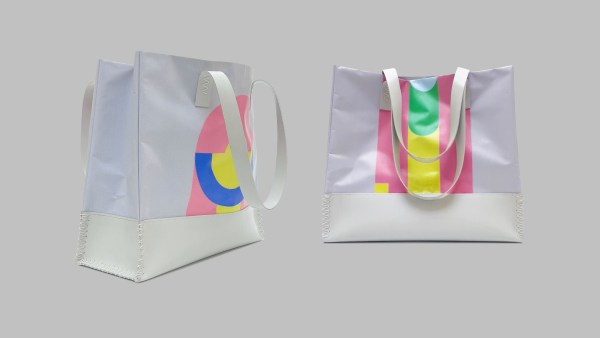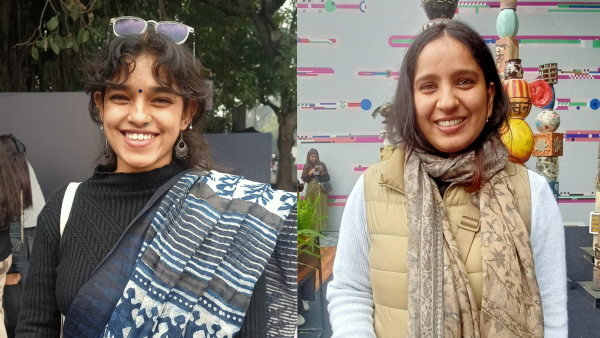Canvas to carry-ons: A tale of art, empowerment, and sustainability at India Art Fair
As you step into the world of the India Art Fair, your gaze is immediately captivated by the grand facade that beckons visitors and encourages them to pause and absorb the play of digital bars emitting vibrant pixels. A symbolic representation of our digital age, where everything is encoded, this spectacle sets the stage for an event beyond artistic expression, delving into sustainability and empowerment.
Amidst the chilly Delhi winters, the art fair emerges as a thaw, and what truly warms the soul is the trifecta of art, sustainability, and empowerment woven into the fabric of the fair’s facade. Crafted by the artistic duo Jiten Thukral and Sumir Tagra, the facade, New Delhi’s grandest canvas, holds more than just visual allure. As the curtains drew on the 15th edition of the art fair, it is set to undergo a metamorphosis, evolving into collectable tote bags made by Chamar Studio, an accessories brand run by artisans belonging to the Dalit community. It also trains leather workers to design eco-friendly bags.

Thukral and Tagra initially faced challenges with their recycling plan, leading them to opt for another solution: upcycling. “Initially, we wanted to avoid the use of plastic altogether. However, at the same time, there were some technical problems in changing the material to something else. But once we decided to proceed with the flex, I proposed that we can turn the entire design into chunks of bags,” says Tagra.
 Collectable tote bags made by Chamar Studio, an accessories brand run by artisans belonging to the Dalit community. (Photo: Chamar Studio)
Collectable tote bags made by Chamar Studio, an accessories brand run by artisans belonging to the Dalit community. (Photo: Chamar Studio)
At the largest art fair in India and arguably South Asia, evidenced by a record 108 exhibitors, even a single stride towards the environment will likely trigger significant repercussions. It is not just about scale, it is also about conscious steps towards a greater purpose, for art is, in today’s context, loaded with responsibility. As beautifully obscure as it is, it is also a response to the lived reality of our everyday lives. This rationale prompted the director of the art fair, Jaya Asokan, to collaborate with Chamar Studio.
While Jiten Thukral describes the partnership as a “natural choice,” Asokan emphasises its positive signalling, underscoring the importance of representation and inclusion.
“For us, inclusion is integral — it’s woven into our core values. Diversity, inclusion, and sustainability are paramount in every project we undertake. When selecting a studio, opting for a Dalit-run one was particularly appealing, as it not only aligns with our commitment to diversity but also highlights the talents of leather artists. Our decisions are consciously made to embrace diversity and inclusivity at every opportunity,” says Asokan.
Emerging from the Dharavi slums, Chamar Studio stands as a testament to creativity born from adversity, embarking on its artistic journey despite being initially labelled as ‘low-quality work’ and ‘unacceptable’.
The founder of Chamar Studio, Sudhir Rajbhar, reflects on a time when navigating the art world demanded more than just talent, “To even enter galleries, you should speak fluent English and dress a certain and ‘appropriate’ way. I made my way up through all this.”
He says that the bags would be crafted by blending flex with rubber. Approximately five or six skilled artisans, mostly hailing from Dharavi, will aim to produce two bags daily once the facade is removed.
“Traditionally, leather workers have been undervalued for their craft. This is why I established Chamar – to instil a sense of respect in society for our artistry. The India Art Fair serves as the ideal platform for us,” Rajbhar says.
Thus, the bag will transcend its mere functionality to become a living testament to the resilience and creativity of its artists, with untold stories woven into every thread.
“Through this bag, we’ll have a slice of their life which we could never experience,” says Bhuvan Arora, a visitor at the fair.
Repurposing the facade may seem like a solution, but it only prolongs the environmental harm caused by non-degradable materials, points out Rubina Rajan, a fair visitor. “With sustainability, the idea is to reduce the waste in the first place. Combining plastic with other materials can complicate decomposition and have long-term effects on the environment. You shouldn’t complicate waste further,” she affirms.
Meanwhile, another visitor, Vrinda Singh, advocates a return to traditional Indian art practices that embraced sustainability, such as ‘madhubani’ and ‘pattchitra’, urging a rediscovery and incorporation of eco-friendly practices.
 Fair visitors, Rubina Rajan and Vrinda Singh
Fair visitors, Rubina Rajan and Vrinda Singh
International art fairs, including prominent ones in Basel, Miami, Maastricht, and Hong Kong, increasingly acknowledge their environmental impact. The FIAC in Paris claims a 44 per cent waste recycling rate in 2019, while Art Basel implemented a carbon offsetting scheme during its Miami edition, as per artprice.com.
Closer home, Asokan reveals that they previously repurposed the facade for homeless shelters and reused floors and walls at the fair for other events. The food court also has eco-friendly packaging, resulting in zero landfill waste last year.
The tote bags will be not only collector’s items and conversation starters but also symbols of conscious fashion. They will demonstrate that art and fashion can collaborate to create something beautiful, both aesthetically and ethically.
Disclaimer: The copyright of this article belongs to the original author. Reposting this article is solely for the purpose of information dissemination and does not constitute any investment advice. If there is any infringement, please contact us immediately. We will make corrections or deletions as necessary. Thank you.





